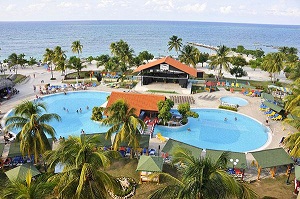 Together with food and agriculture, pharmaceuticals and biotechnology, tourism features among key spheres opening the doors to Cuban development.
Together with food and agriculture, pharmaceuticals and biotechnology, tourism features among key spheres opening the doors to Cuban development.
In a recent interview, the President of Cuba’s Chamber of Commerce, Orlando Hernández, noted the importance of foreign resources, in the form of credit (the country is currently unable to access certain sources given blockade restrictions) or investments, in helping to achieve greater domestic growth.
That said, even after the country’s new Foreign Investment Law was approved in 2015, the Ministry of Tourism (Mintur) continued to be the organization offering the greatest number of opportunities for investors “from abroad.”
It would be impossible to fit all the proposals on this page. However, Hernández highlighted the need to increase hotel capacities and standards, mainly in Havana and heritage cities, as well as diversify the country’s tourist product through more non-hotel offers.
According to José Daniel, Mintur business director, the industry currently has 94 foreign investment projects, including 27 related to hotels and seven new initiatives linked to marina administration and marketing services.
INSIDE HOTELS
74 hotel marketing and administration contracts have been signed, almost 20 with foreign firms, which currently manage over 39,600 rooms across the island.
Aiming to diversifying the competition, the ministry is working on establishing agreements with renowned international chains across 58 facilities (new and existing). In this sense, explains José Daniel, it is hoped that the companies will contribute to the development of the hotels they will be managing. For example, the expert noted that contracts are currently being drawn up for the Neptuno-Tritón Hotel in Miramar, which instead of development rights would give the Cuban part freeholder privileges to all assets.
The expert continued, reporting that the Riviera, Vedado-Saint John’s and Plaza hotels are among some of the facilities based both in and outside of the capital that are scheduled to undergo renovation works with foreign financing (be it from long-standing partners such as Meliá and Iberostar or other debut companies from Europe and Latin America).
To Excelencias of Colombia and French company Warwick International Hotels, the two new management firms which began operating in Cuba in 2014, must be added the prestigious Kempinski Company from Switzerland and Banyan Tree from Singapore.
With a focus of renovating hotel infrastructure, Mintur is offering 27 development plots in Guardalavaca (north of Holguín province), the south central cost (specifically Cienfuegos and Trinidad) and the beaches of Santa Lucía (Camagüey) and Covarrubias (Las Tunas).
According to the Mintur business director, there are currently no new opportunities in the historic center of the Cuban capital, nor its network of northern cays, but other zones in Havana and Varadero (Matanzas) will be considered in the future.
BEYOND ACCOMODATION
Although Mintur initiatives include the construction of modern technology theme parks, they do not feature activities related to dolphin centers, marinas and complementary services. The main opportunities for foreign entities to invest in tourism facilities, according to José Daniel, are primarily linked to golf courses, spread over eleven initiatives in the first stage, foreign partners for ten of which have already been identified.
On route to transforming Cuba into one of the Caribbean’s top golfing destinations, two joint enterprises have been created, responsible for hotel construction – with British and Chinese financing – in Carbonera and Bello Monte, respectively; meanwhile, work is currently underway to identify other new sites throughout the country, Daniel adds.
In addition to these projects – worth over 400 million dollars – the third foreign venture in Pinar del Rio’s Punta Colorada, comprising of a 25 year investment scheme with a Spanish company, also features.
“The deficit of non-hotel services is countered by other attractions including the zip-line, crystal tower or new ski cable, on offer in Cayo Coco and Cayo Guillermo,” notes the director.
He clarified that although Cuba is a renowned beach destination (with over 80% of rooms catering for vacationers seeking this modality), sector policy is directed toward carrying out integrated nature and heritage tourism projects, linked with sporting and cultural activities.
The official highlighted that big investors, absent two or three years ago, “today want to contribute to the development of areas such as Viñales, Trinidad or northern Camagüey, which lack infrastructure, but are abundant in natural resources”.
Studies are even being carried out into the construction of the country’s first airport hotel, while the ministry is also collaborating with the body responsible for marketing Cuban medical services, in order to promote so-called health tourism, which could offer travelers a better quality of life and increase sales of Cuban products.
From Swiss financed eco-hotels, to the renovation of campsites in order to provide quality eco-tourism offers, Cuba continually monitors the sector (which grows annually) with a view to improving sustainable practices and respect for the environment.
A key problem which sometimes affects the quality and speed of these development and investment processes is related to ongoing difficulties with the size and capacity of the workforce, especially in regards to construction, notes the Mintur business director.
One of the most important things we saw in 2015, José Daniel states, was the implementation of new legislation which has enabled us to “better organize our efforts and promote Cuba as an important area for investment and a very safe tourist destination.”
(Granma)